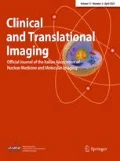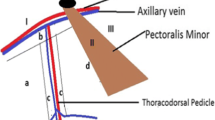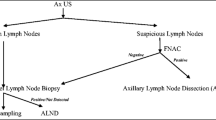Abstract
The last 5 years have been marked by major changes in the approach used to diagnose and treat disease in the axilla for breast cancer patients. Among the current controversies the sentinel lymph node biopsy has been put in question, at least for selected groups of patients. Making of the currently surgical procedure a minimally-invasive one, may be the way between abandoning the sentinel lymph node biopsy and keeping an invasive method of diagnostics. In order to implement a non-surgical needle-based procedure new imaging technologies have arisen in the last years. Freehand SPECT/ultrasound, contrast-enhanced ultrasound and photo-acoustic imaging using dyes for lymphatic mapping enable all to distinguish on the real-time ultrasound image sentinel lymph nodes from others. If combined with large volume needle-biopsy techniques like aspiration-based, freezing-based, pneumatic-driven or cauterization systems, extracting a significant amount of the sentinel lymph node(s) is possible. This opens new technical options towards a non-surgical sentinel lymph node biopsy in the axilla, which for the sake of terminology we name axillary sentinel node aspiration biopsy (a). This work summarizes the current state of art in the technology needed for SNAB and points out challenges and pitfalls, but also the fact that physicists and engineers have done their work and it is up to the medical community to evaluate its usefulness.







Similar content being viewed by others
Notes
Patients undergoing breast conserving surgery with T1/2 N0 M0 and 1-2 positive SLNs.
Many approaches for injection exist, e.g. [14].
Depending on the used tracer, the age of the patient and the injection protocol.
This can be done by using big sized molecules which physically tend to get stuck in lymph nodes or targeted markers, like in the case of tilmanocept which has components with high affinity to receptor proteins which are highly expressed in macrophages and dendritic cells [15].
We understand here conventional SPECT as SPECT using a gantry to hold and move the detectors (typically 1-3 gamma cameras) around the patient. In freehand SPECT as contrast, the detector is a gamma probe or a small gamma camera commonly held by the hand of the operator [16].
References
Giuliano AE, McCall L, Beitsch P, Whitworth PW, Blumencranz P, Leitch AM, Saha S, Hunt KK, Morrow M, Ballman K (2010) Ann Surg 252(3):426–432. http://www.ncbi.nlm.nih.gov/pubmed/20739842 (discussion 432–433)
Giuliano AE, Hunt KK, Ballman KV, Beitsch PD, Whitworth PW, Blumencranz PW, Leitch AM, Saha S, McCall LM, Morrow M (2011) JAMA 305(6):569–575. http://www.ncbi.nlm.nih.gov/pubmed/21304082
(2012) Interdisciplinary S3-Guideline for Diagnostics, Therapy and Follow-Up of Breast Cancer—AWMF Register No.: 032–045OL, AWMF online (website of Arbeitsgemeinschaft der Wissenschaftlichen Medizinischen Fachgesellschaften e.V.). http://www.awmf.org/uploads/tx_szleitlinien/032-045OL_k_S3__Brustkrebs_Mammakarzinom_Diagnostik_Therapie_Nachsorge_2012-07.pdf. Accessed 1 Feb 2016
(2014) NCCN Clinical Practice Guidelines in Oncology—Breast Cancer, Version 1.2014, NCCN Guidelines (website of National Comprehensive Cancer Network). http://www.24hmb.com/voimages/web_image//upload/file/20140422/72881398143429924.pdf. Accessed 1 Feb 2016
Gentilini O, Veronesi U. Breast (2012) 21(5):678–681. http://www.ncbi.nlm.nih.gov/pubmed/22835916
Reimer T, Hartmann S, Stachs A, Gerber B (2014) Breast Care (Basel) 9(2):87–95. http://www.ncbi.nlm.nih.gov/pubmed/24944550
Donker M, Straver ME, van Tienhoven G, van de Velde CJ, Mansel RE, Litière S, Werutsky G, Duez NJ, Orzalesi L, Bouma WH, van der Mijle H, Nieuwenhuijzen GA, Veltkamp SC, Helen Westenberg A, Rutgers EJ (2013) Eur J Cancer 49(9):2093–2100. http://www.ncbi.nlm.nih.gov/pubmed/23522754
Kittaneh M, Montero AJ, Glück S (2013) Biomark Cancer 5:61–70. http://www.ncbi.nlm.nih.gov/pubmed/24250234
Zaknun JJ, Giammarile F, Olmos RA, Vidal-Sicart S, Mariani G. Eur J Nucl Med Mol Imaging 39(1):1–2. http://www.ncbi.nlm.nih.gov/pubmed/21997718
Motomura K, Inaji H, Komoike Y, Kasugai T, Nagumo S, Hasegawa Y, Noguchi S, Koyama H (2001) Eur J Surg Oncol 27(2):141–145. http://www.ncbi.nlm.nih.gov/pubmed/11289748
Wilhelm AJ, Mijnhout GS, Franssen EJ (1999) Eur J Nucl Med 26(4 Suppl):S36–S42. http://www.ncbi.nlm.nih.gov/pubmed/10199931
Surasi DS, O’Malley J, Bhambhvani P (2015) J Nucl Med Technol 43(2):87–91. http://www.ncbi.nlm.nih.gov/pubmed/25956693
Offodile R, Hoh C, Barsky SH, Nelson SD, Elashoff R, Eilber FR, Economou JS, Nguyen M (1998) Cancer 82(9):1704–1708. http://www.ncbi.nlm.nih.gov/pubmed/9576292
Pelosi E, Bellò M, Giors M, Ala A, Giani R, Bussone R, Bisi G (2004) J Nucl Med 45(2):220–225. http://www.ncbi.nlm.nih.gov/pubmed/14960639
Azad AK, Rajaram MV, Metz WL, Cope FO, Blue MS, Vera DR, Schlesinger LS (2015) J Immunol 195(5):2019–2029. doi:10.4049/jimmunol.1402005. http://www.ncbi.nlm.nih.gov/pubmed/26202986 (Epub 2015 Jul 22)
Wendler T (2016) Intraoperative 3D Nuclear Imaging and Its Hybrid Extensions. In: Perkins AC, Lees JE (eds) Gamma Cameras for Interventional and Intraoperative Imaging, 1st edn. CRC Press, USA, pp 70–96
Wendler T, Hartl A, Traub J, Ziegler SI, Navab N (2008) Proc Annual Meeting of Society of Nuclear Medicine (SNM 2008). New Orleans, USA
Wendler T, Herrmann K, Schnelzer A, Lasser T, Traub J, Kutter O, Ehlerding A, Scheidhauer K, Schuster T, Kiechle M, Schwaiger M, Navab N, Ziegler SI, Buck AK (2010) Eur J Nucl Med Mol Imaging 37(8):1452–1461. http://www.ncbi.nlm.nih.gov/pubmed/20354851
Okur A, Hennersperger C, Runyan B, Gardiazaball J, Keicher M, Paepke S, Wendler T, Navab N (2014) Med Image Comput Comput Assist Interv 17(Pt 1):577–584. http://www.ncbi.nlm.nih.gov/pubmed/25333165
Paepke S, Gruber I, Blohmer JU, Ohlinger R, Thill M, Kühn T, Hahn M (2015) Proc St. Gallen Breast Cancer Conference. Vienna, Austria
de Bree R, Pouw B, Heuveling DA, Castelijns JA (2015) AJNR Am J Neuroradiol 36(11):2153–2158. http://www.ncbi.nlm.nih.gov/pubmed/26294647
Bluemel C, Kirchner P, Kajdi GW, Werner RA, Herrmann K (2016) Clin Nucl Med 41(3):e141–e142. http://www.ncbi.nlm.nih.gov/pubmed/26284776
Server A, Jones S, Cox K, Weeks J, Mills P, Jones P (2009) Br J Surg. 96(11):1295–1299. http://www.ncbi.nlm.nih.gov/pubmed/19847869
Sever A, Mills P, Weeks J, Jones SE, Fish D, Jones PA, Mali W (2012) AJR Am J Roentgenol 199(2):465–470. http://www.ncbi.nlm.nih.gov/pubmed/22826414
Garcia-Uribe A, Erpelding TN, Krumholz A, Ke H, Maslov K, Appleton C, Margenthaler JA, Wang LV (2015) Sci Rep 5:15748. http://www.ncbi.nlm.nih.gov/pubmed/26510774
Stoffels I, Morscher S, Helfrich I, Hillen U, Leyh J, Burton NC, Sardella TC, Claussen J, Poeppel TD, Bachmann HS, Roesch A, Griewank K, Schadendorf D, Gunzer M, Klode J (2015) Sci Transl Med 7(317):317ra199. http://www.ncbi.nlm.nih.gov/pubmed/26659573
Galimberti V, Cole BF, Zurrida S, Viale G, Luini A, Veronesi P, Baratella P, Chifu C, Sargenti M, Intra M, Gentilini O, Mastropasqua MG, Mazzarol G, Massarut S, Garbay JR, Zgajnar J, Galatius H, Recalcati A, Littlejohn D, Bamert M, Colleoni M, Price KN, Regan MM, Goldhirsch A, Coates AS, Gelber RD, Veronesi U, International Breast Cancer Study Group Trial 23-01 investigators (2013) Lancet Oncol 14(4):297–305. http://www.ncbi.nlm.nih.gov/pubmed/23491275
Tomkovich K, McGinnis M (2008) J Vasc Interv Radiol 19(2):S114
Whitworth PW, Simpson JF, Poller WR, Schonholz SM, Turner JF, Phillips RF, Johnson JM, McEachin FD (2011) Ann Surg Oncol 18(11):3047–3052. http://www.ncbi.nlm.nih.gov/pubmed/21947585
Damera A, Evans AJ, Cornford EJ, Wilson AR, Burrell HC, James JJ, Pinder SE, Ellis IO, Lee AH, Macmillan RD (2003) Br J Cancer 89(7):1310–1313. http://www.ncbi.nlm.nih.gov/pubmed/14520465
van Rijk MC, Deurloo EE, Nieweg OE, Gilhuijs KG, Peterse JL, Rutgers EJ, Kröger R, Kroon BB (2006) Ann Surg Oncol 13(1):31–35. http://www.ncbi.nlm.nih.gov/pubmed/16372147
Britton PD, Goud A, Godward S, Barter S, Freeman A, Gaskarth M, Rajan P, Sinnatamby R, Slattery J, Provenzano E, O’Donovan M, Pinder S, Benson JR, Forouhi P, Wishart GC (2009) Eur Radiol 19(3):561–569. http://www.ncbi.nlm.nih.gov/pubmed/18797874
Ganott MA, Zuley ML, Abrams GS, Lu AH, Kelly AE, Sumkin JH, Chivukula M, Carter G, Austin RM, Bandos AI (2014) ISRN Oncol 2014:703160. http://www.ncbi.nlm.nih.gov/pubmed/24649373
García-Lallana Valbuena A, Saiz-Mendiguren R, Martinez Regueira F, Sola JJ, Elizalde A, Pina Insausti LJ (2011) Proc Annual European Congress of Radiology. Vienna, Austria. doi:10.1594/ecr2011/C-1364
Whelehan P, Vinnicombe SJ, Brown DC, McLean D, Evans A (2014) Clin Radiol 69(8):849–852. http://www.ncbi.nlm.nih.gov/pubmed/24894653
Acknowledgments
The authors will like to thank Dr. Ali Sever, Dr. Ingo Stoffels and Dr. Joachim Klode for the imaging material (contrast-enhanced ultrasound and photo-acoustic imaging with ICG). Further they would like to thank Mr. Martin Horn and Mr. Matthias Keicher for suggestions and comments on the large-lumen needle biopsy systems.
Author information
Authors and Affiliations
Corresponding author
Ethics declarations
Conflict of interest
The author discloses that he is a minor shareholder (<5 %) of the limited-liability for-profit German company SurgicEye GmbH. This company marketed in the past products for freehand SPECT imaging.
Research involving human participants and/or animals
This manuscript is a review only citing research involving human participants as reported by the respective authors in the respective references.
Informed consent
This manuscript is a review only citing research by other authors as cited, as a result an informed consent is not applicable.
Rights and permissions
About this article
Cite this article
Wendler, T., Paepke, S. Axillary sentinel node aspiration biopsy: towards minimally invasive lymphatic staging in breast cancer. Clin Transl Imaging 4, 377–384 (2016). https://doi.org/10.1007/s40336-016-0205-8
Received:
Accepted:
Published:
Issue Date:
DOI: https://doi.org/10.1007/s40336-016-0205-8




